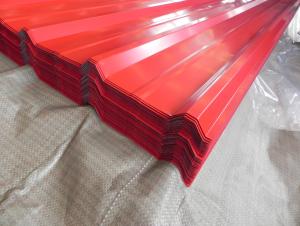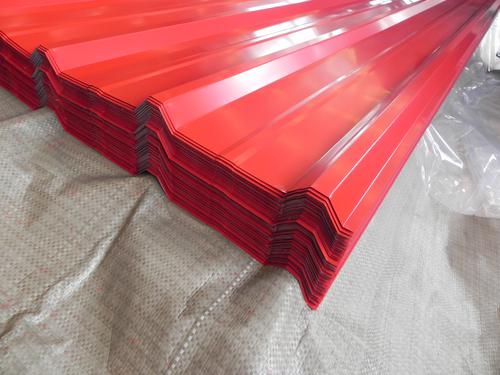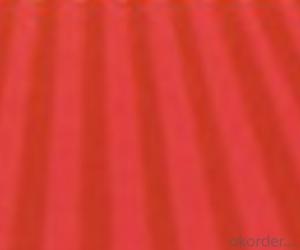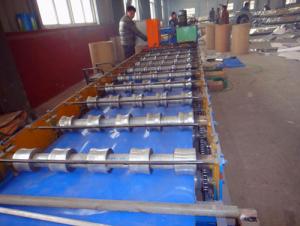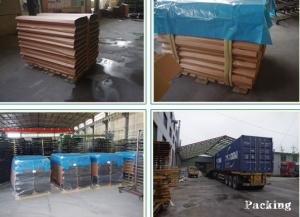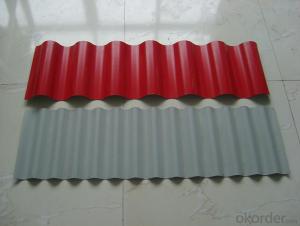color coated roofing sheet
- Loading Port:
- China Main Port
- Payment Terms:
- TT OR LC
- Min Order Qty:
- -
- Supply Capability:
- -
OKorder Service Pledge
OKorder Financial Service
You Might Also Like
color coated roofing sheet
1) Quality Standard & Grade: JIS G3302, SGCC / ASTM 653M CQ/ EN10142 DX51D+Z
2) Thickness: 0.14mm-0.60mm Width: 914mm / 1000mm / 750-1250mm (BC)
3) Thikness tolerance: +/-0.02mm Width tolerance:+/0.02mm
4) Zinc coating : 60g/m2-180g/m2,Z60-Z180
5) color film thickness:20micro(doubled)
6) Surface Treatment: chromated , non oiled, skin passed
7) Packing: export standard packing,packed with moisture resistant paper and metal
wrapping,securely tied for export,on metal skids) Country of Origin :
8)Applications:widely used for roofs, outer walls, cabinets
9)Delivery Time :30 days;Shipment: By bulk vessel or By container
10)payment L/C T/T
- Q: What is the typical coefficient of thermal expansion of a steel sheet?
- The typical coefficient of thermal expansion of a steel sheet is around 10.8 x 10^-6 per degree Celsius.
- Q: What are the common thicknesses for galvanized steel sheets?
- The common thicknesses for galvanized steel sheets typically range from 0.4 to 3.0 millimeters, depending on the specific application and requirements.
- Q: How do steel sheets perform in terms of fire resistance?
- Steel sheets have excellent fire resistance properties. They do not burn, melt or contribute to the spread of fire. Due to their high melting point, they retain their structural integrity even at high temperatures, making them ideal for fire-resistant applications such as building construction and industrial settings.
- Q: Can steel sheets be used for agricultural fencing or enclosures?
- Yes, steel sheets can be used for agricultural fencing or enclosures. Steel sheets are highly durable and provide excellent strength, making them suitable for securing livestock and protecting crops. They can be formed into panels or rolls, allowing for easy installation and customization to fit different fencing or enclosure needs. Additionally, steel sheets are resistant to weathering, corrosion, and pests, ensuring long-lasting performance in agricultural environments. Overall, steel sheets are a reliable and effective choice for agricultural fencing or enclosures.
- Q: What is the average thickness of galvanized steel sheets?
- The average thickness of galvanized steel sheets typically ranges from 0.8mm to 3mm, depending on the specific application and industry standards.
- Q: Are steel sheets suitable for manufacturing kitchen appliances?
- Kitchen appliances can be manufactured using steel sheets, which are well-suited for this purpose. Steel is a durable material with many uses in the manufacturing industry. It possesses high strength, making it capable of withstanding the everyday wear and tear experienced by kitchen appliances. Moreover, steel sheets are resistant to corrosion, a vital quality in a kitchen environment where appliances are frequently exposed to water, moisture, and food spills. In addition, steel is a hygienic material that is easy to clean and maintain, making it an ideal choice for kitchen appliances where cleanliness is of utmost importance. Furthermore, steel sheets can be easily shaped and formed into various designs and sizes, allowing for a wide range of kitchen appliances to be produced. Overall, steel sheets possess the necessary properties and characteristics needed for the production of kitchen appliances.
- Q: What is the difference between a steel sheet and a steel plate?
- The differences between a steel sheet and a steel plate are significant. Firstly, the thickness of a steel sheet is typically less than 6mm, whereas a steel plate is generally thicker, measuring 6mm or more. This discrepancy in thickness is primarily attributed to the intended purpose of each product. Steel sheets are commonly used in scenarios where weight and flexibility are crucial, such as in the production of automobile bodies or appliances. Conversely, steel plates are frequently employed in heavy-duty constructions such as bridges, buildings, or machinery, where strength and durability are of utmost importance. Another distinction can be found in the manufacturing process. Steel sheets are usually created through hot rolling, which involves heating the steel above its recrystallization temperature and subsequently passing it between rollers to achieve the desired thickness. On the other hand, steel plates can be made through either hot rolling or cold rolling processes. Cold rolling entails passing the steel through rollers at room temperature, resulting in a more precise and smoother surface finish. Furthermore, the size of steel sheets and plates also differs. Steel sheets are often standardized in terms of width and length, making them more manageable and easier to transport. In contrast, steel plates are available in various sizes and dimensions, providing greater customization options to suit specific project requirements. To summarize, the key distinctions between a steel sheet and a steel plate lie in their thickness, manufacturing process, and intended use. Steel sheets are thinner and lighter, while steel plates are thicker and utilized in heavy-duty applications that demand strength and durability.
- Q: Can steel sheets be used for cladding or facade systems?
- Yes, steel sheets can be used for cladding or facade systems. Steel sheets offer durability, strength, and a sleek appearance, making them suitable for various architectural applications including cladding or facade systems. They can be customized in terms of color, finish, and shape, allowing for versatile design possibilities. Additionally, steel sheets provide weather and fire resistance, making them a reliable choice for exterior applications.
- Q: What is the difference between a coated and uncoated stainless steel sheet?
- A coated stainless steel sheet refers to a stainless steel sheet that has been coated with a protective layer or finish, which could be a polymer or another material. This coating serves to enhance the sheet's resistance to corrosion, scratches, and other forms of damage. The coating also provides a decorative or aesthetic appeal, as it can come in different colors or textures. On the other hand, an uncoated stainless steel sheet refers to a stainless steel sheet that does not have any additional protective layer or finish. It is in its natural state, with its inherent properties and characteristics. Uncoated stainless steel sheets are known for their high resistance to corrosion, durability, and strength. They are commonly used in applications where their natural properties are sufficient to withstand the intended environment. The main difference between coated and uncoated stainless steel sheets lies in their protective properties and appearance. Coated stainless steel sheets offer an extra layer of protection against corrosion and damage, making them suitable for environments where there is a higher risk of exposure to harsh conditions or corrosive substances. They also provide a wider range of design options due to their variety of coatings. Uncoated stainless steel sheets, on the other hand, are preferred in applications where the natural properties of stainless steel are sufficient to meet the requirements. They are often used in architectural and structural applications, as well as in industries such as food processing, pharmaceuticals, and medical equipment, where hygiene and durability are essential. In summary, the difference between a coated and uncoated stainless steel sheet lies in the additional protective layer and aesthetic options offered by the coating. Coated stainless steel sheets provide enhanced resistance to corrosion and damage, as well as a wider range of design choices, while uncoated stainless steel sheets rely on their inherent properties for durability and strength. The choice between the two depends on the specific application and the desired balance between protection, aesthetics, and cost.
- Q: Can steel sheets be used for decorative wall panels?
- Yes, steel sheets can be used for decorative wall panels. They can provide a modern and industrial aesthetic to a space and offer durability and versatility in design options.
Send your message to us
color coated roofing sheet
- Loading Port:
- China Main Port
- Payment Terms:
- TT OR LC
- Min Order Qty:
- -
- Supply Capability:
- -
OKorder Service Pledge
OKorder Financial Service
Similar products
Hot products
Hot Searches
Related keywords
